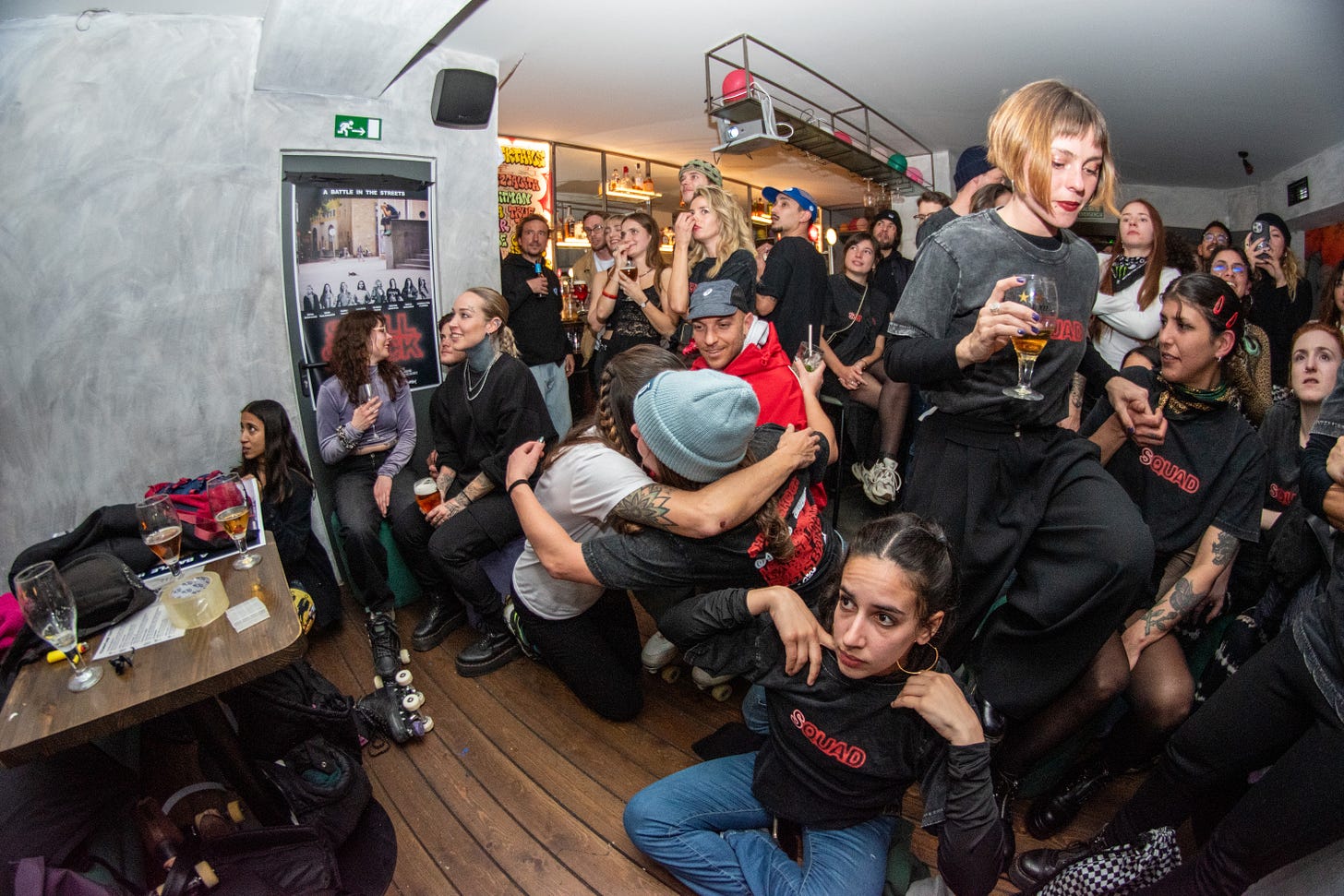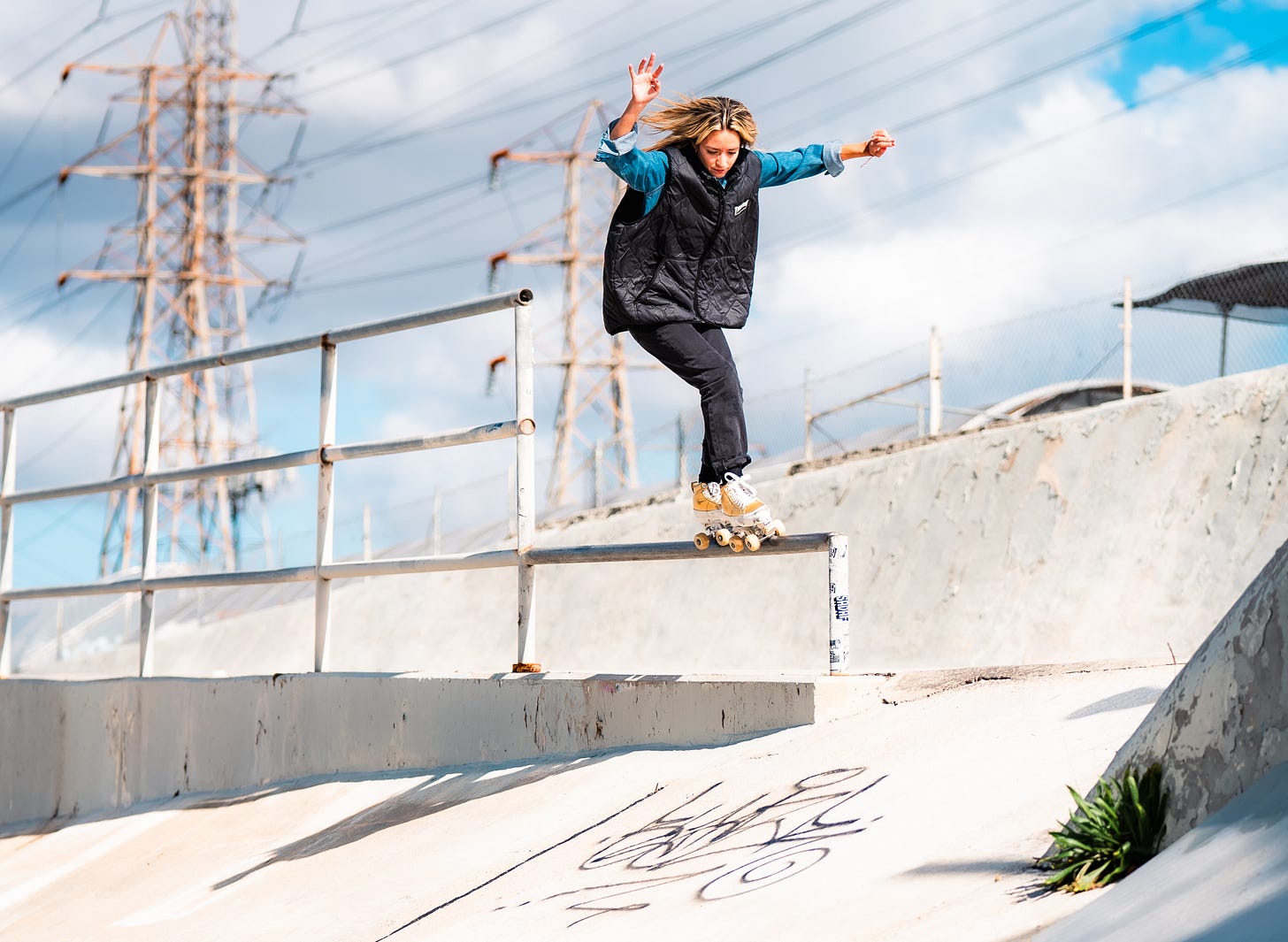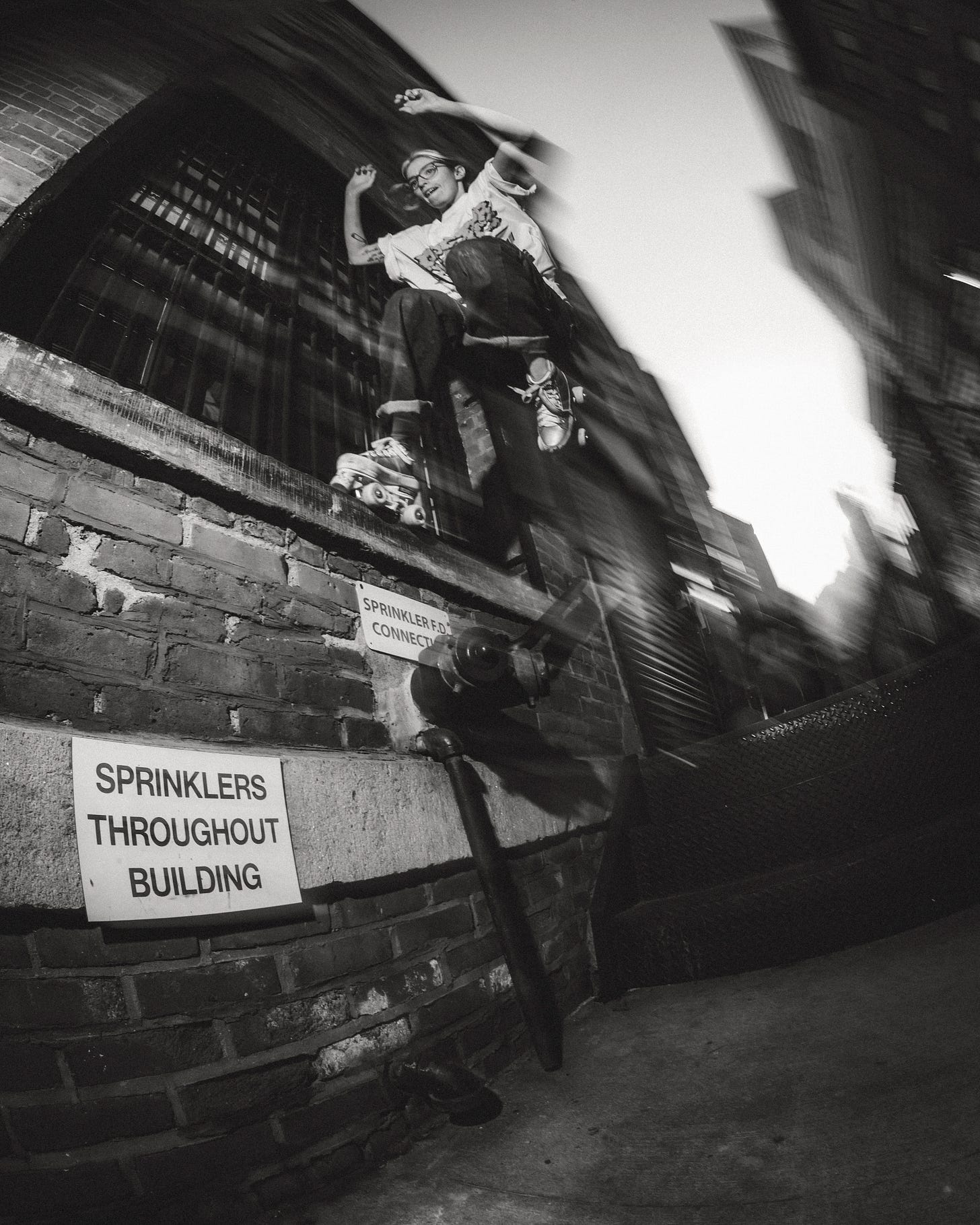Barbie Part 1: Becoming a pro skater
From having her own Chaya pro-model to working at Lazo, Barbara Arganaraz has been blazing a trail for years. In the first part of this deep-dive Q&A, she shares what it took to get here.

There’s still only a handful of roller skaters who have gone beyond pushing the sport forward and become icons, recognised around the world for redefining what’s possible on eight wheels. Barbara Arganaraz, aka Barbie Patin, is one of them, and talking to her, it’s clear that this didn’t happen by accident.
Back in 2016, the Argentinian skater was broke, staying with a friend in Barcelona and living off noodles when she made a self-funded skate video that instantly attracted the attention of brands and skaters around the world — in this interview she explains for the first time what she did to scrape the money together to finish it. She went on to work with companies like SkatePro, Triple 8 and Chaya, who put out the ‘Barbie Patin Kismet ’ roller skates in 2019: the first pro-model deal of its kind.
In the years since then, Barbie has continued to grow as an athlete and leader in the industry. 2023 was the year that Lazo’s first full-length video Fast Forward came out, breaking new ground for professionally made, polished quad-skate videos. It ends with Barbie box-grinding the legendary, terrifying Hollywood 16 handrail before being carried around in an Argentinian football shirt, looking dazed and tearful. She won Fantom’s Roller Skater of the Year award the same year.
Fast Forward was followed up in January 2025 by Shell Shock, Lazo’s second video, which again sets a new bar for mind-blowing street skating. Barbie has been working behind the scenes with Lazo, as well as in front of the camera, and I got in touch to find out stories from the shoot and what she’s up to at the company.
The conversation ended up sprawling well beyond that topic. It’s clear that Barbie is a someone who is intentional about everything she does, as well as funny, compassionate and determined. Here’s part one of our freewheeling chat, which took place a few days after the Shell Shock premiere and encompasses the lengths she went to to buy her first skates, the day she landed the Hollywood handrail, and her belief in signs from the universe.
Congratulations on Shell Shock! You must be so stoked.
Yeah, it was incredible to see the final work with all my friends. I was crying. It’s too much.
What was the premiere like in Barcelona?
I was a bit nervous before, I didn’t know if many people were going to come. When we got to the bar, it was totally empty, there wasn’t even any random people drinking. But just after eleven, people started to come, and then the bar filled up, not only with roller skaters but skateboarders, roller bladers, people that don’t skate.
It was super emotional. Nobody could believe the video, not even the people that were part of it — because we can’t watch the video parts until the video comes out. That’s one of the rules.
So you hadn’t seen the footage beforehand?
I was helping with the whole video, but not my part, because it’s hard to be neutral. We talk with other skaters about which bits they like when we’re together, but at the end, you cannot have control of the editing of your tricks or the music. You have to let it go and trust the people working behind the scenes. That’s why all my teammates were so excited and emotional, because they were watching the video parts for the first time with all the people.
It’s funny that the Barcelona premiere started at 11pm. From an English point of view, that’s so Spanish. That’s when our events finish.
And then we were waiting for people until 11.30 or 12!
How long has this video been in the works?
Over a year and a half.

Do you still have a day job, or do you purely make a living through roller skate-related work?
I roller skate and help with brands. With Triple 8, I help them develop products and with Chaya, I help them with content. I help my teammates get content. I arrange meetings with photographers and filmers, or I might help with lights while they’re filming. A little bit of everything. But skating, for sure, is my priority. And training. I organise my schedule to do everything.
You grew up artistic roller skating, right?
Yeah I started figure roller-skating at five years old.
And when did you come across park skating?
I was 20 years old, I was working in a hair salon in Argentina, and one of the people in charge of the salon asked me if I can take his kids to skateboarding lessons at the indoor skate park, a block away from my shop. So I’d take this little kid to classes. When I got there I met a few girls who were skating on quads, and it was like, ‘What the fuck is this!’ Like, ‘OK, I think I can do this. I’ve been skating my whole life. I need to try this!’
At this age, I was following my instincts. I wasn’t thinking about the future, studying and going to university. So I went to look for my skates, and I started to be super close to the owner of the skate park. I also started dating one of the skateboarder guys from there, who was the coach. He took me to all the skate parks. At that time, there were not many bladers in Argentina. The skateboarding scene was bigger, so they were the ones who helped me. I spent about three months skating, and then I quit my job, and was like ‘I only want to skate.’ My best friend invited me to Barcelona three months after I started roller skating, and I didn’t even know that Barcelona was the Mecca of skateboarding, and that I would meet a lot of people there who would help me with my career.

I knew the story about you moving to Barcelona, but I didn’t know it was so soon after you started skating.
Yeah, my best friend moved to Barcelona two years before that. We were teenagers, and she promised me, ‘OK, Barbie, I’m going to get a job, I’m going to save money, and I’m going to bring you with me.’ I was trying to save money too, but it’s hard with the currency in Argentina to save money. So, two years later, she bought my ticket, and I came out to Barcelona and stayed at her house.
Then, when you started working with Chaya and got your pro ‘Barbie Patin’ skates, was that the first time a roller skater had a pro model like that?
Yeah, the Kismet boot, the blue one, was the first pro model in roller skating. That was about five years ago.
That deal must have been game-changing for you
Yeah, I started to skate with them, and with all the brands, only for products and for the love of skating. For me, to get a pair of skates was too much. I never told this to anybody, but the first pair of skates that I got, I didn’t have any money. It was hard for me being a Latino coming to Spain. You cannot get a job easily, if you don’t have all the correct documents. I tried to get a job to keep filming my video part, and I did work in some cases, but when the time came to pay me, they didn’t pay me. So I ended up working for free.
Was that in hair salons as well? They just knew they could screw you over and there was nothing you could do?
Yeah. So I was crying; I was 21, I was pretty young. My skates were too old and almost broken, and I don’t see this as something bad, but I had to donate eggs. You get paid for that. So I did that. I didn’t skate for a month, because you can’t skate during that process. And when I got the money, I got my first [proper] pair of skates. I never told this to anybody, because it’s kind of sad.

It’s also beautiful. It shows how you’ll do what you need to do to make it work.
I’m a very spiritual person, and I was like, OK, if this is going to help me to keep doing my passion, and at the same time, I’m going to help a woman who has the desire to become a mother, I think this is a good exchange. It was life-changing, in both directions. That was my mindset, the whole time.
What were the first pair of skates you bought with that money?
Figure-skater roller skates, and Spitfire wheels. I still have those in Argentina, for the memory. So I got my skates, I finished my video part. That was the main mission. I didn’t even want to live in Barcelona, I just wanted to finish my video part with the homies before I go back to Argentina. But that was the worst part of my career, because I wasn’t eating well enough to be an athlete. To be an athlete, you need to sleep good, eat good, follow a lot of steps. At that time I was eating noodles and a lot of shitty food because we didn’t have enough money and we were in a rush to finish the video part. When I finished that, I called my mother and told her, ‘Ma, I need to come back to Argentina. I need you to help me with the ticket, because if not I don’t know what’s going to happen to me. Maybe I sleep in the streets or something.’ So she got my ticket. I finished my video part and we shared it on YouTube, and I came straight back to Argentina.
When it came out, did it feel like the moment you dreamed about? Did you have a premiere party?
No, I didn’t know they existed. I just wanted to post it, and then that’s it, you know. Go back to my normal life.
Did it get attention from brands?
I only wanted to be in contact with Michelle [Steilen], because they were the only skaters at the time, in the USA. There were a few more in other countries, like Lady Trample, a few in Argentina, Moco Dimango and a few others. In Spain it was only Bomba Hache, but she wasn’t in Barcelona, she was living in Galicia.
So did you get in touch with Michelle after that?
The day after I posted the video, Michelle contacted me, and all the Moxi team, and Bones, and Chaya, they contacted me too. I didn’t make the video to get something in exchange. I just did it because it was the goal of the trip, because I’ve been through a lot of things and I wanted to have that memory of Barcelona. Yeah, that was crazy.
What happened next?
From then until now, I’ve been coming to Spain, travelling to other countries, doing workshops, meetings, contests, working on my career. It wasn’t easy. At the beginning I was only skating for products, so I had to work in Argentina, save money and then travel with my own money. Then at one point, I was like, I need help, because if not I need to stay in Argentina and get a job. But then Chaya started to help me. It wasn’t much money, but I was grateful because it meant I didn’t have to get a full-time job. I was working a little bit, and then, with their help, I could save more money and be able to travel. Then the idea of the pro model came out, and we did that. We built a relationship. And then about a year ago, I moved to Barcelona.

How were you first approached about the Lazo team?
I’ve been involved with Lazo forever, since they started. I think it was almost four years ago that they contacted me, and I was super down to do it. Because I was the only one from Argentina, they weren’t sure if they could take me [to the US] to film, but I was like, ‘OK guys, I will be there. No matter what, you don’t even need to pay for my ticket.’
For me, as a skater, it’s a dream, just to have filmers and photographers that are professionals and have been working in the skateboarding scene for 20 years. Wanting a picture, just to have it framed in my house, for me that means the world. Making art with professional people, it’s a dream. So it was like that for me, ‘I don’t need you to pay for anything. I will go.’ And then, at one point, they were like, ‘No, no we’re going to bring you to the States.’
So that’s how we started. Everything was flowing super good for me and with our relationship. It was hard to get the video parts done, and they were always trying to take the roller skating to the next level. It’s nice to share this with a new generation of girls, because they give you time to rest. When they’re like ‘Eye of the Tiger,’ it’s like, ‘OK, you go. I’m going to rest a little bit.’ I’m 31, and [some of] these girls are like, 23, 24, even 19.
To go back to that first Lazo video, Fast Forward. You have said in another interview that the day you shot your grind on the Hollywood High rail was the best day of your life. Can you take me back to that day?
I was out of body. A lot of synchronisation happened that day. I’m always aware of the coincidences. I need to feel that I’m getting the right signs to know that something’s going to work in any situation in life. Otherwise I don’t so it. Do you want me to tell you the story? It’s kind of long!
Yeah, go for it!
It was the year that Argentina won the [football] World Cup. One of the last games was happening, my teammates were filming, and I was in the car, watching the game on my phone with my family. The night before, I had a dream that Argentina was going to win, but it was going to be a hard game, and in my dream we were going to win on penalties. I dreamed the whole game, just as it was. I didn’t tell anyone except my boyfriend and his father, so if it happened, they’d know I wasn’t crazy. Then the game happened exactly like the dream. It was like, ‘What the fuck? Am I a witch, or what?’
After that, we went for dinner with my teammates and my boyfriend, and I told them, ‘Guys, tonight, I’m going to get an Argentina [football] jersey, and tomorrow I’m going to do Hollywood High. I was with Michelle at the time. She has a spot in her first video with Bones that she didn’t land; the street gap. It’s in Hollywood too. And I told her, ‘Michelle, you’ve gotta do your street gap that you didn’t do in your first video. And I’ll do Hollywood High. But first, I need to get my Argentina jersey. Without that, I cannot do it.’
The same night, after dinner, we went looking for stores that sell the jersey. There were only two; we found one, and bought the shirt. And when I walked out there was this big, big wall in front of my face that said ‘Hollywood.’ I told my boyfriend, OK, take a photo of me [in front of this wall.] If I land Hollywood High, I’m going to share this photo with my jersey with this video. I think it’s a sign. But let’s see what happens tomorrow.
The next day we got there, we had to park about six blocks away because we couldn’t find parking by the spot, and as we got out of the car, a guy walking behind us says, ‘Are you going to the Hollywood 16 rail?’ I was like, ‘How do you know?’ He said he’d walk with us because his son is skating there. We started talking, he was from Chile, which is next to Argentina, and we started speaking in Spanish.
When I was getting ready to do the trick, I spent like an hour and a half getting ready mentally, and this guy was always there, giving me support in Spanish. As well as my teammates and everyone. The first try, I was out of body. I didn't even know where I was, because everything happened so fast. I didn’t land it, but nothing [bad] happened. I tried it again. And this guy, before I jumped, said to me ‘You got this.’ You can hear it on the video. And then I landed it. He came to me and we hugged, all of us were hugging. I told him, ‘You were my angel. You were my sign. I realised I can do this because you were here. The universe sent you.’ Everything in my life is that way. I look for these patterns.
I do believe that the more you trust your intuition, the more clearly it speaks to you. That must be a helpful guiding force, to be open to these signs.
I truly believe this. In my mind, I have a map, and I connect everything.
That’s it for Part 1 of this interview! To make sure you don’t miss Part 2, which goes behind the scenes at Lazo and covers the making of Shell Shock, click the button ⬇️



